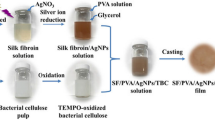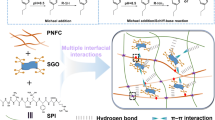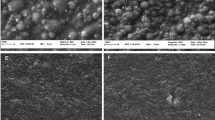Abstract
Soybean protein isolate (SPI) is well-suited to the preparation of composite films due to its abundance, renewability, biodegradability, and favorable film-forming capacity. In this study, different SPI-based composite films were prepared by incorporating nano-ZnO and 2,2,6,6-Tetramethylpiperidine 1-oxyl (TEMPO) oxidized nanofibrillated cellulose (TNFC) separately or together. Nano-ZnO was introduced to endow the films with multifunction capability, while TNFC was introduced to stabilize the nanoparticles. Both the macro optical characterization and micro scanning electron microscope with energy dispersive X-ray (SEM–EDX) analysis indicated that TNFC could significantly decrease nano-ZnO aggregation and improve its dispersibility in the SPI matrix due to the mechanical restriction and physical adsorption effect of TNFC to the nano-ZnO. In addition to the improved dispersibility, incorporating nano-ZnO and TNFC benefitted the mechanical properties and thermo stability of the SPI-based composite films. The tensile strength and Young’s modulus increased by 73 and 57%, respectively, and the maximum degradation temperature increased by 10 °C, compared to that of the unmodified SPI film. These results can be attributed to the hydrogen bonds formed among SPI components, TNFC, and nano-ZnO, which were further examined by attenuated total reflectance-fourier transform infrared spectroscopy and X-ray diffraction analysis. After the incorporation of nano-ZnO, the SPI-based composite films also possessed excellent UV-shielding capacity and superior antimicrobial ability. To this effect, this work provides a valuable reference for nanoparticles dispersion and application in regards to polymer enhancement and multi-functionalization.










Similar content being viewed by others
References
Ai F, Zheng H, Wei M, Huang J (2007) Soy protein plastics reinforced and toughened by SiO2 nanoparticles. J Appl Polym Sci 105:1597–1604
Almutawah A, Barker SA, Belton PS (2007) Hydration of gluten: a dielectric, calorimetric, and Fourier transform infrared study. Biomacromol 8:1601–1606
Althues H, Henle J, Kaskel S (2007) Functional inorganic nanofillers for transparent polymers. Chem Soc Rev 36:1454–1465
Aulin C, Salazar-Alvarez G, Lindström T (2012) High strength, flexible and transparent nanofibrillated cellulose–nanoclay biohybrid films with tunable oxygen and water vapor permeability. Nanoscale 4:6622
Bagheri M, Rabieh S (2013) Preparation and characterization of cellulose-ZnO nanocomposite based on ionic liquid ([C4mim]Cl). Cellulose 20:699–705
Bajpai SK, Chand N, Chaurasia V (2011) Nano zinc oxide-loaded calcium alginate films with potential antibacterial properties. Food Bioprocess Technol 5:1871–1881
Cai J, Kimura S, Wada M, Kuga S (2009) Nanoporous cellulose as metal nanoparticles support. Biomacromol 10:87–94
Chen L, Remondetto G, Rouabhia M, Subirade M (2008) Kinetics of the breakdown of cross-linked soy protein films for drug delivery. Biomaterials 29:3750–3756
Chen J, Chen X, Zhu Q, Chen F, Zhao X, Ao Q (2013) Determination of the domain structure of the 7S and 11S globulins from soy proteins by XRD and FTIR. J Sci Food Agric 93:1687–1691
Chung SJ, Leonard JP, Nettleship I, Lee J-K, Soong Y, Martello DV, Chyu MK (2009) Characterization of ZnO nanoparticle suspension in water: effectiveness of ultrasonic dispersion. Powder Technol 194:75–80
Ciannamea EM, Stefani PM, Ruseckaite RA (2014) Physical and mechanical properties of compression molded and solution casting soybean protein concentrate based films. Food Hydrocoll 38:193–204
Corbierre MK, Cameron NS, Sutton M, Mochrie SGJ, Lurio LB, Rühm A, Lennox RB (2001) Polymer-stabilized gold nanoparticles and their incorporation into polymer matrices. J Am Chem Soc 123:10411–10412
Dash S, Swain SK (2013) Effect of nanoboron nitride on the physical and chemical properties of soy protein. Compos Sci Technol 84:39–43
Echeverría I, Eisenberg P, Mauri AN (2014) Nanocomposites films based on soy proteins and montmorillonite processed by casting. J Membr Sci 449:15–26
Fu F, Li L, Liu L, Cai J, Zhang Y, Zhou J, Zhang L (2015) Construction of cellulose based ZnO nanocomposite films with antibacterial properties through one-step coagulation. ACS Appl Mater Interfaces 7:2597–2606
Garrido T, Etxabide A, Peñalba M, de la Caba K, Guerrero P (2013) Preparation and characterization of soy protein thin films: processing–properties correlation. Mater Lett 105:110–112
González A, Alvarez Igarzabal CI (2015) Nanocrystal-reinforced soy protein films and their application as active packaging. Food Hydrocoll 43:777–784
González A, Strumia MC, Alvarez Igarzabal CI (2011) Cross-linked soy protein as material for biodegradable films: synthesis, characterization and biodegradation. J Food Eng 106:331–338
Grüneberger F, Künniger T, Huch A, Zimmermann T, Arnold M (2015) Nanofibrillated cellulose in wood coatings: dispersion and stabilization of ZnO as UV absorber. Prog Org Coat 87:112–121
Ifuku S, Tsuji M, Morimoto M, Saimoto H, Yano H (2009) Synthesis of silver nanoparticles templated by TEMPO-mediated oxidized bacterial cellulose nanofibers. Biomacromol 10:2714–2717
Jiang H, K-s Moon, Li Y, Wong CP (2006) Surface functionalized silver nanoparticles for ultrahigh conductive polymer composites. Chem Mater 18:2969–2973
Johnsen BB, Kinloch AJ, Mohammed RD, Taylor AC, Sprenger S (2007) Toughening mechanisms of nanoparticle-modified epoxy polymers. Polymer 48:530–541
Jung C (2000) Insight into protein structure and protein–ligand recognition by Fourier transform infrared spectroscopy. J Mol Recognit 13:325–351
Kang HJ, Song XS, Wang Z, Zhang W, Zhang SF, Li JZ (2016) High-performance and fully renewable soy protein isolate-based film from microcrystalline cellulose via bio-inspired poly(dopamine) surface modification. ACS Sust Chem Eng 4:4354–4360
Kanmani P, Rhim JW (2014) Properties and characterization of bionanocomposite films prepared with various biopolymers and ZnO nanoparticles. Carbohydr Polym 106:190–199
Krochta JM, Mulder-Johnston D (1997) Edible and biodegradable polymer films: challenges and opportunities. Food technology (USA)
Kumar P, Sandeep KP, Alavi S, Truong VD, Gorga RE (2010) Preparation and characterization of bio-nanocomposite films based on soy protein isolate and montmorillonite using melt extrusion. J Food Eng 100:480–489
Laurent S, Forge D, Port M, Roch A, Robic C, Vander Elst L, Muller RN (2008) Magnetic iron oxide nanoparticles: synthesis, stabilization, vectorization, physicochemical characterizations, and biological applications. Chem Rev 108:2064–2110
Li Y et al (2013) Strong transparent magnetic nanopaper prepared by immobilization of Fe3O4 nanoparticles in a nanofibrillated cellulose network. J Mater Chem A 1:15278
Li K, Chen H, Li Y, Li J, He J (2015) Endogenous Cu and Zn nanocluster-regulated soy protein isolate films: excellent hydrophobicity and flexibility. RSC Adv 5:66543–66548
Li Y, Chen H, Dong Y, Li K, Li L, Li J (2016) Carbon nanoparticles/soy protein isolate bio-films with excellent mechanical and water barrier properties. Ind Crops Prod 82:133–140
Liu Y, Li K (2007) Development and characterization of adhesives from soy protein for bonding wood. Int J Adhes Adhes 27:59–67
Lodha P, Netravali AN (2005) Thermal and mechanical properties of environment-friendly ‘green’ plastics from stearic acid modified-soy protein isolate. Ind Crops Prod 21:49–64
Lu Y, Weng L, Zhang L (2004) Morphology and properties of soy protein isolate thermoplastics reinforced with chitin whiskers. Biomacromol 5:1046–1051
Martins NCT et al (2013) Antibacterial paper based on composite coatings of nanofibrillated cellulose and ZnO. Colloids Surf Physicochem Eng Aspects 417:111–119
Nafchi AM, Alias AK, Mahmud S, Robal M (2012) Antimicrobial, rheological, and physicochemical properties of sago starch films filled with nanorod-rich zinc oxide. J Food Eng 113:511–519
Odegard GM, Clancy TC, Gates TS (2005) Modeling of the mechanical properties of nanoparticle/polymer composites. Polymer 46:553–562
Park S, Bae D, Rhee K (2000) Soy protein biopolymers cross-linked with glutaraldehyde. J Am Oil Chem Soc 77:879–884
Ramanathan T et al (2008) Functionalized graphene sheets for polymer nanocomposites. Nat Nanotechnol 3:327–331
Rhim JW, Gennadios A, Handa A, Weller CL, Hanna MA (2000) Solubility, tensile, and color properties of modified soy protein isolate films. J Agric Food Chem 48:4937–4941
Rhim JW, Gennadios A, Weller CL, Hanna MA (2002) Sodium dodecyl sulfate treatment improves properties of cast films from soy protein isolate. Ind Crops Prod 15:199–205
Saito T, Kimura S, Nishiyama Y, Isogai A (2007) Cellulose nanofibers prepared by TEMPO-mediated oxidation of native cellulose. Biomacromol 8:2485–2491
Salarbashi D, Mortazavi SA, Noghabi MS, Fazly Bazzaz BS, Sedaghat N, Ramezani M, Shahabi-Ghahfarrokhi I (2016) Development of new active packaging film made from a soluble soybean polysaccharide incorporating ZnO nanoparticles. Carbohydr Polym 140:220–227
Samaele N, Amornpitoksuk P, Suwanboon S (2010) Effect of pH on the morphology and optical properties of modified ZnO particles by SDS via a precipitation method. Powder Technol 203:243–247
Shankar S, Teng X, Li G, Rhim J-W (2015) Preparation, characterization, and antimicrobial activity of gelatin/ZnO nanocomposite films. Food Hydrocoll 45:264–271
Shin Y, Bae I-T, Arey BW, Exarhos GJ (2008) Facile stabilization of gold-silver alloy nanoparticles on cellulose nanocrystal. J Phys Chem C 112:4844–4848
Song F, Tang DL, Wang XL, Wang YZ (2011) Biodegradable soy protein isolate-based materials: a review. Biomacromol 12:3369–3380
Sun L, Chen W, Liu Y, Li J, Yu H (2015) Soy protein isolate/cellulose nanofiber complex gels as fat substitutes: rheological and textural properties and extent of cream imitation. Cellulose 22:2619–2627
Tian H, Wang Y, Zhang L, Quan C, Zhang X (2010) Improved flexibility and water resistance of soy protein thermoplastics containing waterborne polyurethane. Ind Crops Prod 32:13–20
Ullah A, Wu J (2013) Feather fiber-based thermoplastics: effects of different plasticizers on material properties. Macromol Mater Eng 298:153–162
Vaz CM, van Doeveren PFNM, Yilmaz G, de Graaf LA, Reis RL, Cunha AM (2005) Processing and characterization of biodegradable soy plastics: effects of crosslinking with glyoxal and thermal treatment. J Appl Polym Sci 97:604–610
Wang S-Y, Zhu B-B, Li D-Z, Fu X-Z, Shi L (2012) Preparation and characterization of TIO2/SPI composite film. Mater Lett 83:42–45
Wu Q, Zhang L (2001) Effects of the molecular weight on the properties of thermoplastics prepared from soy protein isolate. J Appl Polym Sci 82:3373–3380
Xiao S, Gao R, Gao L, Li J (2016) Poly(vinyl alcohol) films reinforced with nanofibrillated cellulose (NFC) isolated from corn husk by high intensity ultrasonication. Carbohydr Polym 136:1027–1034
Xiong R, Lu C, Wang Y, Zhou Z, Zhang X (2013) Nanofibrillated cellulose as the support and reductant for the facile synthesis of Fe3O4/Ag nanocomposites with catalytic and antibacterial activity. J Mater Chem A 1:14910
Xu F, Dong Y, Zhang W, Zhang S, Li L, Li J (2015) Preparation of cross-linked soy protein isolate-based environmentally-friendly films enhanced by PTGE and PAM. Ind Crops Prod 67:373–380
Yang C, Wu J, Hou Y (2011) Fe3O4 nanostructures: synthesis, growth mechanism, properties and applications. Chem Commun (Camb) 47:5130–5141
Yu J, Yang J, Liu B, Ma X (2009) Preparation and characterization of glycerol plasticized-pea starch/ZnO–carboxymethylcellulose sodium nanocomposites. Bioresour Technol 100:2832–2841
Zhang J, Gao G, Zhang M, Zhang D, Wang C, Zhao D, Liu F (2006) ZnO/PS core–shell hybrid microspheres prepared with miniemulsion polymerization. J Colloid Interface Sci 301:78–84
Zhang S, Xia C, Dong Y, Yan Y, Li J, Shi SQ, Cai L (2016) Soy protein isolate-based films reinforced by surface modified cellulose nanocrystal. Ind Crops Prod 80:207–213
Zheng H, Ai F, Wei M, Huang J, Chang PR (2007) Thermoplastic soy protein nanocomposites reinforced by carbon nanotubes. Macromol Mater Eng 292:780–788
Acknowledgments
This research was supported by “The Fundamental Research Funds for the Central Universities” (No. 2016ZCQ01) and “the National Natural Science Foundation of China” (Project 51779005/E090301).
Author information
Authors and Affiliations
Corresponding author
Ethics declarations
Conflicts of interest
The authors declare no conflict of interest.
Rights and permissions
About this article
Cite this article
Yan, Y., Wang, K., Wang, Z. et al. Fabrication of homogeneous and enhanced soybean protein isolate-based composite films via incorporating TEMPO oxidized nanofibrillated cellulose stablized nano-ZnO hybrid. Cellulose 24, 4807–4819 (2017). https://doi.org/10.1007/s10570-017-1469-5
Received:
Accepted:
Published:
Issue Date:
DOI: https://doi.org/10.1007/s10570-017-1469-5




